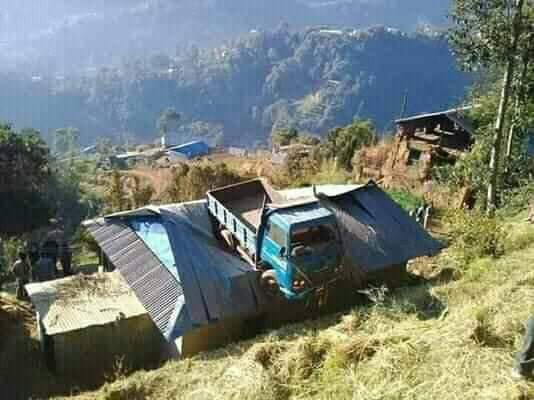Intrepid earthbag researcher and advocate Patti Stouter sent me this remarkable photo taken in Nepal. She says, “I just got this photo from someone who helped build about 500 earthbag houses in Nepal after the quakes. This heavy truck had an accident and rolled off an adjacent mountain road and onto the roof of this building. The result? There was virtually no damage to the house other than the truss system. Not a vibration test, but the impact must have been significant.
Patti continued, “Most of their one story plus loft houses included rebar inserted between 3 vertical pinning rebar at each corner, and inserted rebar spaced in the walls. They used strong cohesive fill soil, and strong welded metal tube window and door frames. The loft floor was a diaphragm welded of metal tubing also. I think we’re close to establishing why earthbag resists quakes. I’ve got a report that clearly shows the strength of normal inserted rebar walls.”
My intuition about the reason earthbag technology holds up so well to seismic disturbances has mostly to do with its inherent resilience. The matrix of bags, barbed wire, vertical pinning, plaster mesh, and plaster, and the fact that the fill itself has some give if necessary, just allows the building as a whole to flow with, or absorb, the forces and not disintegrate into fragments.

Wonderful job !!coukd you please help me locate bags 18 x30 I cant seem to find this size bag anywhere
If you go to http://earthbagbuilding.com/resources.htm#supplies there are many possible suppliers listed.
Wow what a story!! For all the people who have done earthbag building does anyone have a rough idea of how many bags someone can fill per day without killing themselves! I am looking at using earth bag as a retaining wall in a large pond/pool and just wanted to work out some rough timelines. Much appreciated
When I was building my house, I used to lay 2 or 3 courses around a perimeter of about 75 feet in one day. This works out to about 14 square feet per hour. I was filling the bags from a nearby pile of scoria (crushed volcanic rock).
Awesome thank you. Was that filling and laying each day? One course will be about 20 mt (60 feet) so thinking my two boys and I should be able to knock it over quickly when we get to doing it!
Yes, although scoria is easy to fill and carry because it is so light.
Hi Kelly- maybe not the best place to put this question, but I see that you are responding. But I was looking at using Scoria with the Raschel bags, or Hyperadobe. Do you see any problem with that? the Buttresses and interior walls I was just going to use an Adobe dirt, I was thinking for more strength in the Buttresses and mass on the interior. Do you think mixing the two at the intersections will be a problem, like compacting differently? Thanks
You could use scoria to fill the mesh bags as long as the mesh is fine enough to contain it. You might still use barbed wire between the courses because there will not be the merging between them like there is with soil fill. I don’t imagine there would be much problem with interfacing the two differently filled portions.
Wow! Part 2 could tell how they got it off of the roof!
This is wild! I saw on here some time back an account of someone having a car run into their roundhouse made with earthbags and it just cracked the plaster a bit but the photographic evidence with this one is astounding.